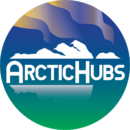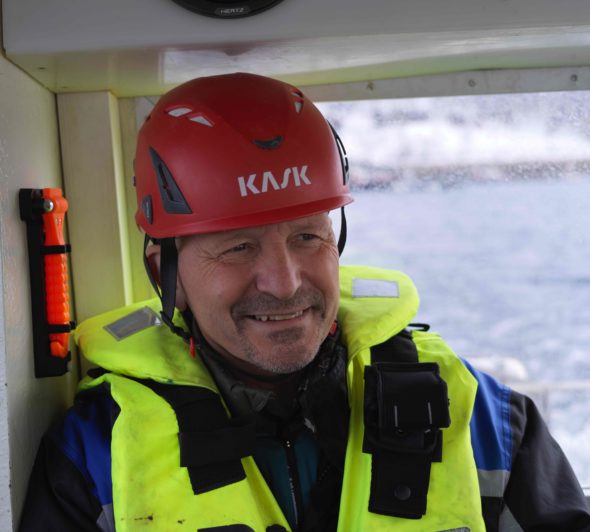Dr. Roy Robertsen is a senior scientist for one of the ArcticHubs’ partner organisations, NOFIMA; he is specialised in seafood and aquaculture research, fish farming research and development, and environment sustainability. Within the project, he is researching the trends and industrial development of fish farms around the hub of Varangerfjord (Norway), its environmental sustainability and the ripple effects of new sea-related industries on fish, sea, costs and people.
In this interview, he introduces us to some project applied research steps that he is currently carrying on in Varngerfiord hub, and he also shares insights on the possible future scenarios for the European Arctic.
How did your professional journey through research in the Arctic begin?
My first experience researching the Arctic started in 1988 with profitability analysis in seafood and shrimp industry. One of the main tasks I had was to collect economic data. At the time, you had to collect data directly from accounting books. I had to travel to visit the companies and many of them were located in Tromsø and Finnmark counties. It was before the email systems arrived. However, one of the advantages of moving the length and breadth of coastal areas was that I got to know well the coast and people. This allowed me grow a deep understanding of the functioning, finances, organisation and development of fishing industries of Norway.
Later on, projects using sea related resources with socio-economic perspectives became more prominent in my research work.
Do you remember the first time you directly came across Arctic land-use conflict issues? and how this has impacted your research work subsequently?
Yes, quite clear. It was in 2009, and together with some local fishermen and an aquaculture organisation I was arranging a workshop named “Operating in the blue field”. Its purposes were to:
- improve the dialogue on land resources and contribute to long-term cooperation among users of the coastal area of northern Norway
- bring out relevant issues and challenges
- identify what areas could develop specific and practical projects with the aim of ensuring access to and utilisation of sea zone and resources of northern Norway, and possibly within a rational and sustainable framework.
The seminar brought together a number of diverse participants from the profit sector, local municipalities and environmental research & development programmes; it was as a very useful meeting for exchanging on sea related resources, use and conflict. The interest around common challenges was high and a number of final inputs and needs arose such as:
- renewal of coastal zone planning in Northern Norway
- mapping of sea area development and area conflicts in Northern Norway coastal zone
- raising competence in coastal zone planning
- improve the regime for processing aquaculture applications
- prepare the effects of introduced protection regimes in the coastal zone
- develop models for sustainable site structure
These inputs are still useful to take into consideration for Arctic sustainable use and from these also the ArcticHubs project is bringing forward the action.
This is the right time to concretise the efforts to ensure long-term sustainability and resilience to the Arctic sea, land and people: that means we need to be effective with new methods for mapping fish, we have to foster dialogue amongst stakeholders and population; we also need to do the follow-up of the inter-municipal coastal zone plan that is being prepared in Varangerfjord, and many other actions..
What is your role within ArcticHubs project?
My main role so far has mainly been related to assessing socio-economic impacts of sea related industries in the hub of Varanger, that will be then compared to the data emerging from other hubs included in the project (it is within work package 3). First part of the action was to conduct participative data collection and then an investigation of methods and approaches to social license to operate (SLO) around the Arctic hubs.
We are now in the process of conducting an evaluation of methods and models in aquaculture. What we have experienced so far is that established theoretical models, primarily from mining, are not necessarily suitable for aquaculture. It will be exciting to see if the concept, which is well established for mining, is suitable for the other industries that are part of Arctic hubs. As part of the project team I am conducting field work, and interviews, I am also part of the testing process of the PPGIS – public participation geographic information system – in Varanger.
What are the main tasks and research objectives in Varanger hub?
Climate change and globalisation have transformed the Arctic. Today, efforts to ensure long-term sustainability and resilience to future environmental, socio-cultural, economic and political factors in the Arctic are a high priority for national authorities, international institutions and non-state actors.
The ArcticHubs project is developing solution-oriented tools that can be used also in Varangerfjord, such as an improved GIS system (the one we are testing PPGIS), guidelines for “social license to operate”, and methods for future scenarios planning for Arctic communities, industrial stakeholders, decision-makers and other relevant actors.
These tools will help to create and implement local/regional development and planning strategies aiming to combine new economies with traditional activity and possible resolve land use conflicts. They will also serve to increase the resilience of both new and existing industries and communities to environmental, economic and political changes in the Arctic and Varangerfjord.
Coexistence, participation and dialogue are keywords of the project activities. What we do in the hub of Varangerfjord within ArcticHubs concerns the following practical steps:
- testing and using new methods for mapping fish, and catching them, on a commercial scale;
- fostering dialogue through events and participation in seminars in Varanger (such one seminar held in Bugøynes last 4th-5th of May 2022, and another one planned in Vadsø for the 6th of September 2022);
- ensure to have follow-up of the inter-municipal coastal zone plan that is being prepared in Varanger;
- present facts related to sea-based industries in Varanger and how this sector affects resilience, population development and job opportunities;
- make visible the ripple effects of the seafood industry and the exploitation of the sea from various industries;
- carry out a PPGIS study that allow participation from the population from Varanger in planning and provides valuable data on people’s views on nature, use of the sea and opinions about sea-related activities/industries.
What is the progress of ArcticHubs in Varangerfjord hub so far? And what consequences is it having locally?
Access to resources from the sea can be a source of conflict.
Conflict around sea resources in Varanger previously was mainly related to fish stocks, catches and access to fishing areas. Today, new industries such as aquaculture and fishing tourism compete for the sea with other sectors, creating potential conflicts over available resources. But it must be said that they also create opportunities for economic growth and job creation. The changes brought about by their presence (by the new industries) increase the need for a more rational and dynamic planning of coastal zones. There is also a need to regulate sea areas beyond municipal boundaries. And our research activities within the Arctichubs are already providing inputs to these type of processes.
With the Ukraine war uncertainty about the future is clearly present and this also affects business and local communities in Varangerfjord.
How do you see the future of the European Arctic and Finnmark county more specifically?
Varanger has a border with Russia and the war against Ukraine is a real “black swan” that appeared in February 2022. Varanger and northern Norway have long historical ties to Russia, historically through the Pomor trade and cooperation, and now through people to people trade. With the war uncertainty about the future is clearly present and this also affects business and local communities in Varanger. Even though there are dark clouds in the sky, we still experience optimism in the North because the fisheries and especially aquaculture are very profitable sectors. However, we see that these industries do not prevent a negative population development especially in the districts that lose out young people who move to central cities.
Biography
Roy Robertsen is a senior scientist at the Department of Industrial Economics of NOFIMA, in Norway. After graduating from The Norwegian College of Fishery Science at UiT – the Arctic University of Norway (1988), he started his career in Fiskeriforskning (now Nofima) for about 6 years. Then he founded and worked in his own consulting firm dealing with research and development projects related to the seafood and aquaculture industry, and for almost 16 years. Later on, in 2010, he was back at Nofima. At Nofima, he has been working on Enterprise resource planning (ERP) systems, environmental assessments, evaluation of regulatory measures in the aquaculture industry, marketing management, quality management, traceability systems, fish welfare, modern salmon stunning systems, coastal zone planning, social licence to operate (SLO), ripple effect studies and coexistence projects. He currently lives and works in Tromsø.

